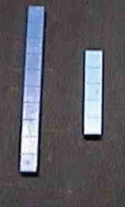Give your students an algorithm to solve problems that makes sense to them. Remember "no concept is beyond the grasp of a child, if it is presented at the child's level." When adding single digits that add up to more than ten break it down into small steps of addition rather than long counting...we will do the same with subtraction and multiplication too. But lets not get ahead of ourselves.
For example,
8+7 = __
For a very small child and even some older students this is daunting because you run out of fingers and you can lose your place. You need two hands to represent 8 AND 7... unlike adding numbers 5 or less. Most students will not have this "memorized" although at Crewton Ramone's House of Math this will come naturally because we will build quite a few 15's, (AFTER we are quite comfortable building 9's and 10's) and soon the answer to 8+7 is as easy as 2+2.
Meantime we ask a bunch of simple questions:
What does 8 want to be? (All the single digits want to be a ten.)
8 wants to be 10.
What does 8 need to be 10?
2! (We have built 10 over and over again so this is easy.)
Is there a 2 in 7? (Of course, remember seven was having a party).
So the 8 takes the 2 out of 7 so it can be 10 and what's left?
5...so we have a 10 and a 5, what's that called?
15.
8+7 = 15.

As an aside, do you see where the "equals sign" comes from?
Fingers are good, this is better and faster. We want to get them off their fingers and into their heads, but they need to know what steps to take. You should also tell a story to add meaning.
If I have 8 kids in the classroom and 7 more kids come in how many kids do I have?
Don't stop there.
I also ask ta few more:
I'm building a 15 and I have 8 what do I need? (8+X=15).
I'm building a 15 and I have 7 what do I need? (7+X=15).
I have 8 chairs in my classroom but there are goning to be 15 kids coming how many more chairs do I need? (8+X=15).
I have 7 chairs in my classroom but there are goning to be 15 kids coming how many more chairs do I need? (7+X=15).
If I have 15 kids and 8 are boys how many are hermaphradites?
Just kidding.
Next step subtraction which is just small addition.
If I have 15 kids and 8 go to recess how many are left? ( 15-8=X )
If I have 15 kids and 7 go to recess how many are left? ( 15-7=X )
Need GIF
You can start to see that addition and subtraction really are inverse functions.
Note we take the number out of the ten! Not the five and the ten...in other words we don't "use up" the five and then take three more out of the ten for 15-8=X the 8 comes out of the 10. HUGELY IMPORTANT.
They should be able to see this after they have just done the addition but what if they come upon one of these problems all by themselves?:
15
-8
or
15
-7
But again just ask simple questions:
Can I take 8 out of 5?
No.
Where must I take it from?
The 10.
And what's left 2.
so 2 and 5 is 7.

Or faster...
Can I take 8 out of 5?
No.
What does 8 want to be?
10.
8 needs 2 to be 10 so lets just add 2 and 5 to get 7.
Skipped some steps there which confuses everybody and anybody who doesn't know all the steps. Kinda like how they teach algebra in regular skool.
Even faster. 15-7...
Do I have enough? (in the "ones place")
No.
Add 3 to 5 to get 8.
Done.
Look, it's this easy:
 Need step where I show 3 all by itself...
Need step where I show 3 all by itself...I tell the students "this is why we love math because the answers are always the same. They don't change. Later when we add 28+7, 35 is EASY. Or 78+7, 85 is easy...pretty soon we can add any two numbers together...but this is step one. Then we can fool around with 80+70...but that's another story.
No comments:
Post a Comment